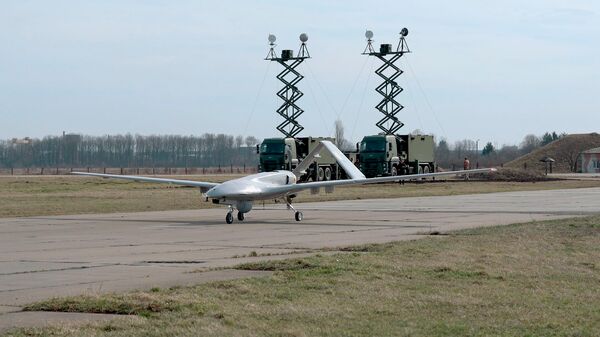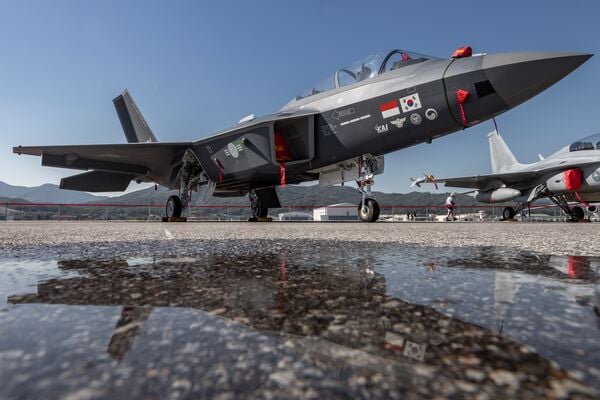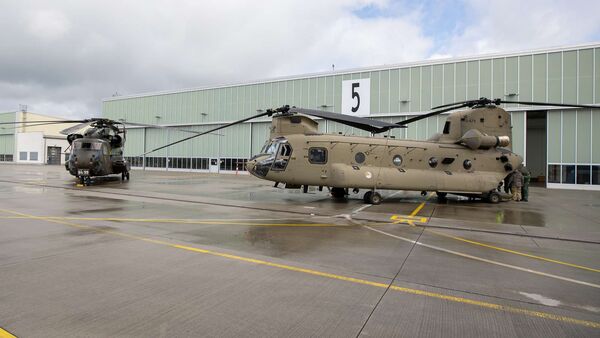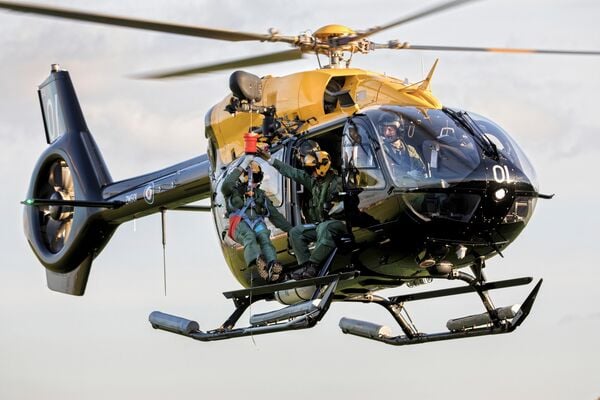- About
- Intara
- Capabilities
- Advisory
- Resources
- News
- Store
Pakistan integrating TB2 into air-defence network
13 October 2022
by Akhil Kadidal & Akshara Parakala


A Ukrainian Bayraktar TB2 UAV with its mobile ground control stations in the background. Previous satellite imagery has identified one TB2 at the PAF's Murid Air Force Base. (Ukroboronprom)
The Pakistan Air Force (PAF) has been working to integrate new unmanned aerial vehicle (UAV) assets into its air-defence network. This includes the country's recent acquisition of the Baykar Bayraktar (Standard-Bearer) TB2 medium-altitude long-endurance (MALE) tactical UAV.
In a statement on 28 September, the PAF said that it conducted an operational air-defence exercise to foster “synergy” in counter-air operations. In video imagery of the exercise, the PAF showed the involvement of two TB2s and at least three Leonardo Airborne and Space Systems Falco UAVs.
Janes has learnt that the UAVs are being integrated with the air-defence network in the PAF's Southern Air Command.
According to the air force, the PAF Chief of Air Staff, Air Chief Marshal Zaheer Ahmed Baber Sidhu, visited an unidentified operational airbase to “assess the integration of newly acquired UAS into the PAF's operational construct”.
South Korea announces new aircraft engine factory
19 April 2024
by Akhil Kadidal


A new engine factory being developed by Hanwha Aerospace at Changwon will produce engines for the KAI KF-21 and the TA-50 multirole trainer aircraft. (Zhang Hui/VCG via Getty Images)
Hanwha Aerospace is building a new factory to produce engines for combat aircraft, including the Korea Aerospace Industries (KAI) KF-21 Boramae 4.5-generation aircraft. The new factory is also expected to support the development of South Korea's new domestic fighter engine programme.
Ground was broken for the 16,530m 2 engine production facility at Changwon on 15 April 2024, the South Korean Ministry of National Defense (MND) said on 17 April. The factory is being developed at a cost of USD30 million and is scheduled to be operational by 2025. The MND added that the factory's priority is the licence production of the 92.1 kN (20,700 lb st) General Electric F414-GE-400 engine for the KF-21.
A Hanwha Aerospace spokesperson told Janes on 19 April that “100%” of the licence manufacture of the F414 engine will be achieved at this factory. “The facility is expected to produce approximately 300 engines annually [after becoming operational], the spokesperson added.
RNLAF helps Luftwaffe prepare Chinook capability
19 April 2024
by Gareth Jennings


A Dutch Chinook (foreground) arrived at Holzdorf Air Base in mid-April to help the Luftwaffe prepare for the arrival of its own Chinooks into the station from 2027. In the background is a Luftwaffe CH-53G currently based at the location. (Bundeswehr)
The Royal Netherlands Air Force (RNLAF) is helping the Luftwaffe prepare for its upcoming Chinook heavy-lift helicopter capability, dispatching one of its own helicopters to the type's future operating station in mid-April.
The Bundeswehr said on 18 April that an RNLAF CH-47F Block 1 Chinook landed for the first time at Holzdorf Air Base (also known as Schönewalde), south of Berlin, to help the Luftwaffe prepare for the arrival of the first of its CH-47F Block II Chinook Standard Range (SR) air-to-air refuelling (AAR)-capable heavy-lift helicopters from 2027 to 2032.
“With the future stationing of the CH-47, Holzdorf Air Base will become a hub for helicopter transport. The [Luftwaffe] is gaining initial experience with the Chinook transport helicopter with its Dutch allies – in flight operations, refuelling, and training,” the Bundeswehr said.
UK contracts H145 helicopters for Brunei, Cyprus missions
19 April 2024
by Gareth Jennings


With the UK already flying the H145 with the UKMFTS training programme, it has acquired additional rotorcraft to take on its Brunei and Cyprus support missions. (Crown Copyright)
The United Kingdom has contracted Airbus to deliver six new Airbus Helicopters H145 rotorcraft to be used in Brunei and Cyprus.
Announced by the Defence, Equipment, and Support (DE&S) branch of the Ministry of Defence (MoD) on 18 April, the GBP122 million (USD152 million) award will see the helicopters acquired to replace the Airbus Puma HC2s (Helicopter Cargo 2) that are supporting the British Army's training mission in Brunei following the recent retirement of the Bell 212s, as well as the Pumas HC2s that performing search-and-rescue (SAR) and support duties at Royal Air Force (RAF) Akrotiri in Cyprus following the recent retirement of the Bell 412s.
Known as Jupiter HC2 in UK military service, the D3-standard five-bladed helicopters are to be delivered later in 2024. The MoD already operates the D2-standard four-bladed H145 in the trainer configuration, with seven Jupiter HT1 (Helicopter Training 1) aircraft in use with the UK Military Flying Training System.
The Pakistan Air Force (PAF) has been working to integrate new unmanned aerial vehicle (UAV) assets ...
Latest Podcasts
Iran Israel analysis
In this podcast Janes analysts discuss the Iranian attacks on Israel on the 14 April. They highlight the military systems used by Iran and the performance and impact of these on Israel. They also discuss the implications of this attack goi...
Listen nowJanes Case Studies
Using Janes Intara to build a common intelligence picture: Russian build up on the Ukrainian border
View Case StudyNews Categories
 Defence Details
Defence Details